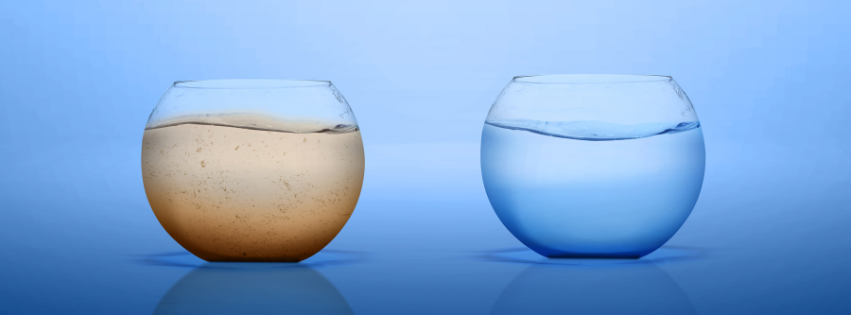
Filtering Your Tap Water: Why It Matters More Than Ever for Your Health
WHY FILTERING YOUR TAP WATER MATTERS MORE THAN EVER
We’re made of water—literally.
Roughly 70% of your body is water, so the quality of what you drink, cook with and bathe in matters deeply.
The majority of the water we drink comes from tap water.
From a consumption perspective, research estimates that 56% of drinking water in the U.S. comes from the tap, while 44% comes from bottled source.
But tap water isn’t only for drinking.
You brush your teeth with it. Wash your face with it. Shower in it.
It flows through your laundry, your dishes, your ice maker.
Tap water is in constant contact with your body.
And yet—much of our tap water isn’t as clean as we think.
IS TAP WATER BAD FOR YOU?
In the U.S., tap water is generally safe and regulated by the EPA.
On paper, we have some of the safest public drinking water in the world.
But “safe” doesn’t mean optimal.
Municipal water often contains a cocktail of chemicals and contaminants:
- Pesticides
- Heavy metals
- Forever chemicals like PFAS (in approximately 50% of our water)
- Disinfection byproducts (DBPs)
- Fluoride
- Pharmaceutical residues
- Endocrine disruptors
And if you live in an older city, aging pipes may be leaching even more into your supply.

HOW TO KNOW IF YOUR TAP WATER IS SAFE
The first step is to educate yourself.
Use the EWG Tap Water Database to look up your zip code.
It shows exactly which contaminants are present—and how they compare to both EPA limits and stricter health guidelines.
Many water systems exceed EPA standards. And experts argue those limits are already too low.
If you’re on well water, it skips municipal treatment, which means you’re responsible for testing and filtering.
WHAT TO KNOW ABOUT PFAS AND TAP WATER
Per- and polyfluoroalkyl substances (PFAS) is often dubbed a forever chemical due to its persistent nature. They encompass man-made chemicals found in a wide range of products, from non-stick cookware to firefighting foam.
As of June 2025, a U.S. Geological Survey (USGS) study estimates that at least 45% of tap water samples across the United States contain detectable levels of PFAS, with higher concentrations in urban areas where industrial activity is prevalent.
PFAS chemicals do not break down easily in the environment or the human body, accumulating over time and posing potential health risks through contaminated tap water.
Exposure to PFAS has been linked to a range of issues, including increased risk of certain cancers (e.g., kidney and testicular cancer), immune system suppression, thyroid dysfunction, and developmental problems in children.
The EPA has set enforceable limits at 4 parts per trillion for certain PFAS compounds, but many water systems still exceed these thresholds due to outdated infrastructure and insufficient regulation.
TAP WATER ISN'T JUST ABOUT WHAT YOU DRINK
Every day exposure to tap water matters more than we realize.
When you shower, your skin absorbs the water, and you inhale the vapor rising with it.
During laundry, any toxins in your tap water can embed in your clothes and linger against your skin.
And household appliances like dishwashers, ice makers, and humidifiers all circulate unfiltered water into the things you eat, drink, and breathe.
HOW TO IMPROVE YOUR TAP WATER
The goal? To make clean water accessible in your home.
Start with what fits your space and budget:
- Faucet filters: Easy to install, no fridge space needed, some last 3 months.
- Water pitcher filters: Affordable, fridge-friendly, change every 2 months.
- Fridge filters: Built-in but vary in effectiveness.
- Showerhead filters: Big impact, low cost. Look into brands like Jolie.
- Whole-house systems: Carbon-based filters run from hundreds to thousands—minimal upkeep, maximum coverage.
- Reverse osmosis (RO) systems: Powerful for drinking and cooking, but strip minerals, so re-mineralization is key.

SMART WATER MOVES BEYOND FILTRATION
Hydration isn’t just about water. It’s about what’s in your water, too.
To learn how to hydrate better, read up on the best hydration fixes or try the following:
- Add electrolytes (sodium, potassium, magnesium)
- Choose mineral-rich filtered water
- Try coconut water or milk (if tolerated)
- Eat water-rich fruits like cucumbers and watermelon
Also, ditch single-use plastic bottles—they’re packed with micro- and nanoplastics.
New research shows the plastic problem is far worse than we thought.
Switching to filtered tap water and a reusable bottle can save ~156 plastic bottles per person per year.
CLEAN WATER IS FOUNDATIONAL
Clean filtered water fuels your cells. Supports your brain. Protects your hormones.
And powers nearly every process in your body.
If there’s one home upgrade that pays dividends every day it's high quality water.
Your health will thank you.
SUMMARY
- Tap water often contains PFAS, heavy metals and other contaminants, even when legally “safe.”
- You absorb water through your skin, lungs and household exposure.
- Filtration systems range from simple pitchers to full-house setups. Something is better than nothing.
- Clean water supports every cell, organ, and system in your body. It's worth the upgrade.
FURTHER READING
When water alone doesn't cut it. Why you need the right balance of electrolytes for cellular function
Lymphatic health is your body’s hidden detox superpower. Discover simple, natural ways to boost it and feel your best
Activated charcoal is a must-have gut and detox tool. Discover how it supports digestion, reduces bloat, and binds toxins
